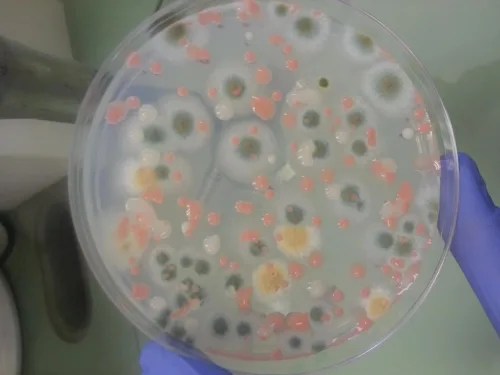Microbiology Program
Overview
No Matter Where We Go, We Take Our Microbes
Everywhere we go, we take microorganisms with us, whether we want to or not. This is true even aboard the “clean” environment of the ISS, which is a closed environment. With a crew of astronauts on board, living, breathing, exercising, and sweating, the ISS is a breeding ground for microbes.
Microbes Can Be Both Friends and Foes

The effects of spaceflight on the biology of microorganisms and on microbial populations are largely unknown. In addition to posing a risk to astronaut health, bio-corrosive microorganisms that grow on metallic surfaces in spacecraft can damage both equipment and hardware. Unlike cruise ships on Earth which can be evacuated, emptied, and cleaned, problems that arise due to microbial contamination on long-duration spaceflight missions can only be resolved using tools and resources already present within the vessel. Understanding how microbial species grow and interact with each other in this environment is the first step in preparing for such a scenario.
While the presence of certain microbes can be problematic, it is also important to remember that many microbial species play important roles in Earth’s various ecosystems. For example, the symbiotic relationships that have evolved between plants and certain bacteria are vital in ensuring plants receive the nutrients they require to grow and flourish. Oxygen-producing cyanobacteria that live in terrestrial bodies of water help replenish Earth’s oxygen. Even the bacteria living within our digestive tracts play an important role in the digestion of our food and the proper absorption of nutrients. The presence of certain microbes may be important for the proper growth of some plants in space and may even be critical for the production of future bio-regenerative life support systems. It is therefore important to keep in mind that reaching an appropriate microbial equilibrium within a spacecraft may be vital for successful long-duration spaceflight missions.
As we examine the impacts of spaceflight on microorganisms, we ask the following:
- What underlying genetic, molecular and biochemical processes are influenced by the spaceflight environment?
- How does the spaceflight environment influence microbial reproduction, growth, and physiology?
- Does long-duration spaceflight alter normal rates of evolutionary change?
- What are the effects of spaceflight on microbial communities as they interact with other organisms to effect processes such as symbioses, biodegradation, nitrogen-fixation, etc.
- What are the mechanisms that effect changes, such as the altered virulence or altered drug resistance, observed in some organisms during spaceflight?
